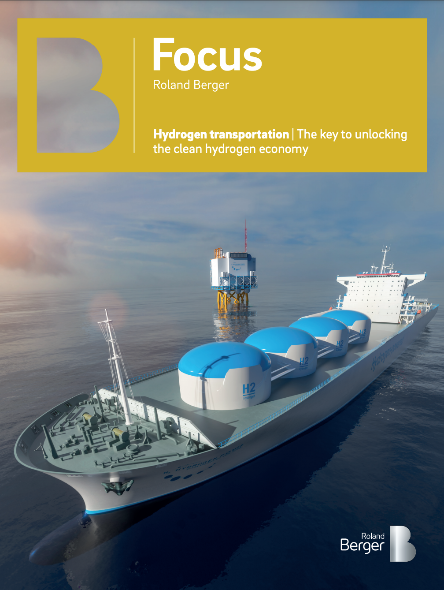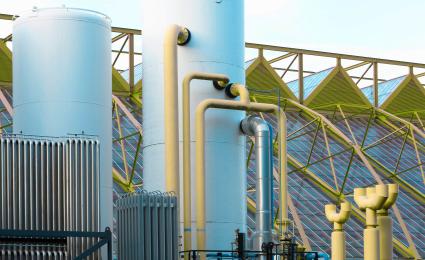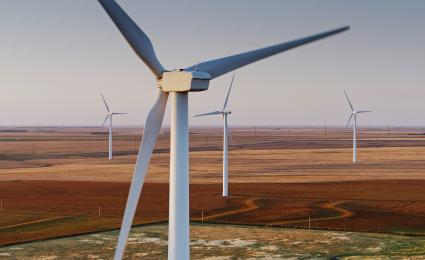Roland Berger is a thought leader in environmental issues and the response demanded from organizations. Our publications cover all relevant areas.


Transporting the fuel of the future
Hydrogen transportation is key to unlocking the clean hydrogen economy
"Getting hydrogen from global production sites to end users at the lowest possible cost will be key to the success of the green economy."
Clean hydrogen is quickly gaining currency as a scalable alternative fuel that could power a climate-neutral economy. But since it is much less dense than most other energy carriers, it poses a significant and often-overlooked logistics problem – specifically, its transportation from future production sites to points of use. The available carrier technologies are often costly, involve complex processes and, in methods such as ammonia, carry practical elements of risk. Therefore, to ensure its commercial viability, it is vital that reliable and cost-effective methods of hydrogen transportation are developed. Roland Berger’s study set out to answer the question of which large-scale transportation technology could be the best solution for the coming decades. While there is no straightforward answer, what is clear is that policy makers and investors need to act now to enable low-cost hydrogen transportation, and be at the forefront of building the infrastructure necessary for a decarbonized economy.
A clean revolution in the making
Clean hydrogen will inevitably play a major role in reaching global decarbonization goals. As all sectors of our economy move to net-zero emissions, total hydrogen demand in Europe is expected to grow to more than 45 m tons by 2050. Whether as fuel or feedstock, clean hydrogen and its derivatives will be especially vital in sectors that are traditionally hard to decarbonize, such as heavy industry and marine transport.
In many consumption centers around the world, Europe being a prime example, the potential for on-site clean hydrogen production is limited though, necessitating its transportation from supply hubs with low-cost renewables, such as the wind farms of the North Sea or solar parks in the Arabian Gulf. Consequently, total "landed" hydrogen costs go up – and the choice of the right transportation solutions becomes critical.
Finding a clean solution
Roland Berger’s publication compares the viability and costs involved in three end-to-end hydrogen transportation technologies: ammonia, liquefied hydrogen and liquid organic hydrogen carriers (LOHC). Pipelines transporting gaseous hydrogen are considered as well, but because of their limitations the focus is on more flexible transportation options.
- Ammonia: Due to its sheer volume and widespread use, the infrastructure and processes for storing and transporting the chemical already exists, making this a viable and cost-effective option. Unfortunately, ammonia’s toxicity and energy-intensive processes of reconverting ammonia back to hydrogen could limit its usage outside large-scale industry.
- Liquefied Hydrogen (LH2): Cooled to −253° C (making it one of the coldest cryogenic gases), hydrogen’s volumetric storage density can be significantly improved. While the infrastructure already exists on a smaller scale, complex processes and substantial initial investment costs make this a more costly option compared to the other carriers, at least in the short run.
- Liquid Organic Hydrogen Carriers (LOHC): Since LOHC is easily handled, transported and stored, the existing infrastructure used to transport fossil fuels can be utilized. While the technology is relatively new and not yet proven at industrial scale, LOHC is nevertheless seen as a promising candidate for the transportation of hydrogen.
It all comes down to costs
To estimate the total cost of ownership (TCO) of the three hydrogen transportation options in 2025, Roland Berger developed a cost-comparison model wherein each technology is tested within four archetypes: large-scale harbor-to-harbor; mid-scale multimodal transportation; small-scale multimodal transportation, and small-scale truck-only transportation.
One of the primary takeaways from the cost comparison model is that there is no one-size-fits-all carrier that fits the transportation archetypes analyzed. For example, regardless of its considerable costs of liquefaction and cooling, LH2 might still be a better option if high-purity liquid hydrogen is required at the point of use. The most viable option for any given scenario will have to ultimately be determined on a case-by-case basis.
Getting the green light
Roland Berger’s study estimates that from mid of the decade onwards, more than one million tons of clean hydrogen will be transported, marking a significant shift in a currently heavily captive industry. While challenges abound, if the hydrogen economy is to be scaled up and carbon emissions reduced, massive investments in transport infrastructure are critical.
In order to make hydrogen-driven decarbonization a reality, governments and investors will need to step up. Significant investments, endorsed and boosted by policy makers, will need to be made in R&D of all the existing transport options, while carrier providers will need to focus on improving their efficiencies and integrating clean options for energy intake. Ultimately, first movers in the sector will have a tremendous advantage and be able to set market standards.
Download the publication to read in-depth about the cost comparisons of large-scale hydrogen transportation options.

Transporting the fuel of the future
![{[downloads[language].preview]}](https://www.rolandberger.com/publications/publication_image/Roland_Berger_STU756_Hydrogen_Transportation_Cover_download_preview.png)
Roland Berger’s study determines that cost-efficient methods of storing and transporting hydrogen are critical to the realization of a decarbonized economy.
Register now to receive regular updates on the future of the hydrogen business.









_tile_teaser_w425x260.jpg?v=770441)












_person_144.png?v=869993)
